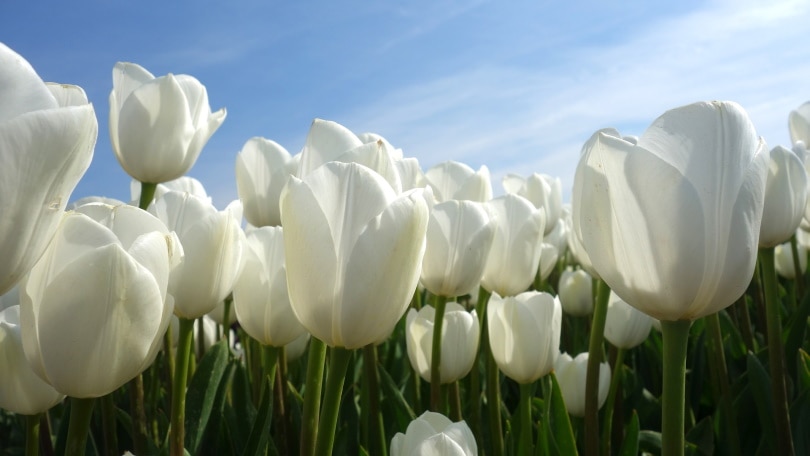Seeds aren’t the only way for a flower to propagate and reproduce. Numerous flower species, some of which you are going to discover in this write-up, use diverse kinds of bulbs as their starting, genetic materials.
These bulbs are primarily agency, underground constructions that have a foods source to kickstart the growth of a plant, but they also have genetic material. There are five sorts of flower bulbs, with a few subtypes, and you will be finding out about each variety in this post.
The 5 Types of Flower Bulbs (with Pictures)
1. True Bulbs

Correct bulbs, also called Dutch bulbs, consist of lateral buds, the basal plate, fleshy scales, the shoot, and occasionally a tunic. We say “sometimes” is simply because the presence of the tunic defines whether or not the true bulb is tunicate or imbricate. Right here are some particulars about the diverse subtypes of real bulbs:
- A tunicate bulb has the tunic, a form of outer ‘skin’. Its purpose is to protect the interior scales that store food, usually in the form of carbohydrates.
- The opposite of a tunicate bulb is the imbricate bulb. These bulbs don’t have the outer layer of tunic, which requires them to stay moist before they’re planted. If they’re allowed to, the scales will dry out, which will damage the bulb and damage your plant.
A tulip bulb is a very good case in point of a tunicate bulb as it is entirely protected in a protecting layer. The contrast to that, an imbricate bulb, would be the lily.
2. Corms

Corms are an additional type of flower bulb, but a far more primitive kind of bulb. In comparison to accurate bulbs, the primary distinction is that corms are solid inside of. They’re primarily food containers in the type of big stems.
They only have a basal plate and a tunic to protect them, with a increasing position. Crocuses, for case in point, increase from corms.
3. Tubers

Tubers are massive stems with no basal plate. Rather, they have progress nodes that are sometimes also called the eyes of a tuber. They also do not have a protective layer.
The tunic would only be in the way of the tuber, as the expansion nodes normally unfold close to the entire bulb. Roots commence creating from those nodes, and thus the flower grows. An instance of a tuber plant caladiums.
Gardeners uncover this very useful as they can chop a single bulb and have several crops expand out of it. If there is at minimum one wholesome eye, a plant will experienced.
Tubers are superb storages of food, as they have adequate vitamins to get the plant through the wintertime. Since of this, many plants that expand from tubers can make it by way of the winter.
4. Rhizomes

These underground stems are pretty simple to work with they act as a container for plant nutrition and kickstart new plants’ growth. One thing that sets them aside from other flower bulbs is how they increase. As an alternative of spreading vertically like most other bulb sorts, they distribute horizontally. Some individuals get in touch with it the ‘creeping rootstalk’ simply because of this. This way, they can keep much more food and preserve area.
A rhizome will press the largest roots out of the soil to build. Like tubers, they’re straightforward to get apart and start a number of vegetation from a solitary rhizome (if it’s large ample). Irises are a excellent case in point of a rhizome plant.
5. Tuberous Roots

The last kind of bulb on our record, tuberous roots are distinct in construction to all the other bulbs simply because they don’t retailer food in the stems. Alternatively, they store meals in the root.
They are primarily an underdeveloped variety of bulb, as their roots are really primitive and only developed the added perform of storing meals. Dahlias are examples of bouquets that have tuberous roots.
Final Thoughts: Types of Flower Bulbs
And there you have it – 5 kinds of flower bulbs that you can appear throughout in any garden and an additional bulb-like structure that may possibly occur in helpful. Bulbs are a all-natural way of gathering and retaining beneficial vitality and vitamins and minerals that’s required for a plant to grow.
They are also the driving force driving some of the most popular bouquets on Earth, which includes tulips, lilies, daffodils, and irises. Numerous flowers and vegetables also arrive from bulbs, like potatoes, onions, garlic, and bananas.
No issue which flower bulb you choose for your garden, we guess you will be pleased with the vivid and beautiful bouquets that fill your out of doors place.
Highlighted Image Credit score: Pixabay
Contents
